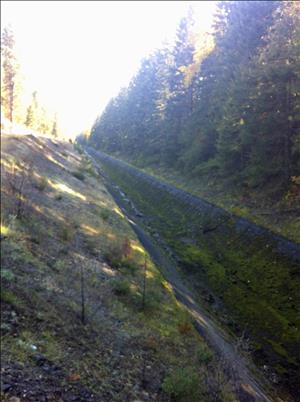On December 19, 1925, U.S. Secretary of the Interior Hubert Work (1860-1942) signs the contract for construction of the Kittitas Reclamation District's Main Canal.
The
Evening Record
of Ellensburg proclaims this "the biggest news for Ellensburg in a quarter of a century" ("Work Signs Contract!"). It is the fruition of a decades-old dream of building a major canal, beginning high on the Yakima River near Easton, to irrigate vast stretches of the fertile Kittitas Valley all the way to Ellensburg and beyond. It takes until 1929 to complete the Easton Diversion Dam and the 26-mile-long Main Canal. The first water flows in 1930. Two other branch canals will be built onto the end of the Main Canal. Ultimately, the Kittitas Reclamation District's Main Canal and its various branches (known collectively as the High Line) will irrigate nearly 60,000 acres and will enable the Kittitas Valley's agricultural economy to grow and thrive.
A Bigger Dream
Kittitas Valley farmers and entrepreneurs had long dreamed of a major irrigation canal beginning high on the Yakima River and watering a vast expanse of the Kittitas Valley. Smaller ditches were dug throughout the valley as early as the late 1880s, but the cost and difficulty of digging a huge canal put the bigger dreams on hold until the Kittitas Reclamation District was formed on September 5, 1911. The district's goal was to build an ambitious, high-line canal, but the district soon came to the conclusion that the entire canal would have to be concrete-lined, and the costs would exceed the proposed $5 million bond issue. Other financial plans were floated over the ensuing years, with no more success. In 1919, a historical survey of the state's irrigation projects noted that, "if the Kittitas Reclamation District Canal be constructed as planned," it would finally complete the irrigation of nearly the entire Kittitas Valley (Boening, p. 32). Yet the long-awaited Main Canal still lacked funding.
In 1921, the Kittitas Reclamation District entered into a contract with the U.S. Bureau of Reclamation, with the idea of reviving the Main Canal plan. The Bureau issued an engineering report in 1925 that contained the basic outline of what would become the Main Canal project. Finally, at the end of 1925, federal funds were appropriated and Secretary Work signed the contract for the long-awaited project. The news was greeted in Kittitas County with giant headlines that blared, "Work Signs Contract! Last Obstacle to the Hi Line Is Removed" ("Work Signs Contract!").
"The people here know and appreciate that the contract is the most liberal ever granted any district by the federal government, state or other agency," said The Evening Record in Ellensburg. "It gives then every opportunity to develop their lands under the most favorable conditions and payments and it is confidently expected that it will be the model project for the country" (Work Signs Contract!").
Construction of the Canal
The construction of the 26-mile-long Main Canal and its branches began in the spring of 1926 "with the clearing of trees and brush to make way for the big drag-line machines digging the main canal" (Fitzhugh). A construction camp was built on nearby Hayward Hill not far from Thorp. At the project's peak, in 1928, the work force consisted of 1,440 men. The giant ditch was dug using dynamite, steam engines, horse-drawn teams -- and old-fashioned sweat and shovels. Construction claimed the life of one Roslyn man in 1928, when a rock fragment struck him during blasting.
The project required so much piping that in 1928 the U.S. Reclamation Bureau built its own concrete-pipe plant in Ellensburg, which produced nearly 20,000 linear feet of pipe. Some sections of pipe were "big enough for a man to stand in" (Fitzhugh). Meanwhile, construction of the Easton Diversion Dam, to divert water into the Main Canal from the Yakima River, began in 1927 and was finished in 1929. The dam is 66 feet tall, with a crest length of 248 feet.
The Main Canal was finished in 1929 and the first water rushed down the canal during the 1930 growing season. The water couldn't have arrived at a more opportune time. The Great Depression had begun, and Kittitas County was already suffering through a coal-mining slump and a protracted drought.
The entire project, including the North Branch and South Branch, which split from the end of the Main Canal near Thorp, was completed in 1933. By 1935, the canal was irrigating 50,000 acres and the county's agricultural industry began to thrive as it never had before. The project would eventually "grow to 330 miles of canals and laterals, including 30 siphons, 11 tunnels, 10 wasteways, one pumping plant, one flume and three fish facilities," costing a total $11.2 million (Fitzhugh).
By 2014 the irrigated acreage had grown to 59,122.

